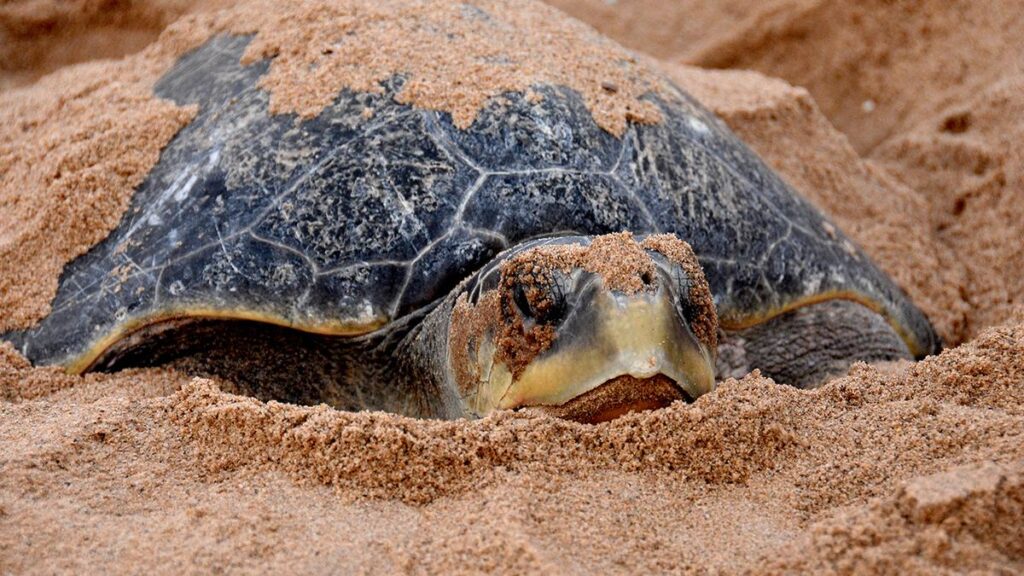The Olive Ridley turtle (Lepidochelys olivacea), a vulnerable sea turtle species, made headlines earlier this year: a record-breaking seven lakh turtles had nested at Odisha’s Rushikulya beach alone in March.
These turtles are renowned for their synchronised mass nesting events called arribada, a Spanish word that means “arrival”. For many people, the Rushikulya arribada signalled hope — but for conservation biologists, it raised critical questions about the future of these vulnerable animals and whether human interventions, even well-meaning ones, could change the course of nature itself.
While some localised populations of Olive Ridley turtles have expanded, the IUCN Red List has estimated that the number of Olive Ridleys worldwide has dropped by 30-50% since 1960. The Olive Ridleys’ primary nesting sites are along the Pacific coasts of Mexico and Central America, although Odisha is also a particularly critical location.
The State’s 480-km-long coastline hosts three major nesting beaches: Gahirmatha, between the Brahmani and Baitarani river mouths; Devi, 100 km south of Gahirmatha; and Rushikulya, 320 km further south.
The where of it
Research has found that Olive Ridley turtles that hatch at a nesting site are ‘imprinted’ with a map of the local magnetic field. Decades later they return with remarkable precision to the site by following this map. The phenomenon is called philopatry: a blend of memory, environmental factors, and the earth’s geomagnetic cues. Philopatry is reinforced by a multiplier effect: as females with strong philopatric tendencies increase in number, they reinforce site fidelity across generations.
There are other ecological factors too. Studies on the Loggerhead sea turtles (Caretta caretta) have also revealed that their nesting zones are near free swirls of cold water in the seas — called cold-core eddies — that move nutrients up from the deep sea to the surface, including those rich in chlorophyll. Other factors that affect their choice of nesting sites include salinity, land slope, risk of predation, and rainfall.
Nesting sites are considered more suitable if more turtles have nested there before — but as turtle populations swell whereas the size of the most favourable nesting grounds doesn’t, beaches often become battlegrounds. A population that arrives after another has already nested at a beach might dig up existing nests — female turtles are guided by olfactory cues and female urine — and break the eggs. This happened earlier this year during the second mass-nesting event at Rushikulya.
Eggs that are broken and displaced attract predators. Experts previously believed predators used visual cues to detect turtle nests. More recent research has found that olfactory cues, especially the scent of disturbed soil and broken eggs, are more significant. Thus, a species’ most successful survival strategy may also sow the seeds of its decline.
In sea turtles, temperature determines the sex of hatchlings. Studies of Loggerhead turtles have found that their populations are more female when they nest on warmer beaches. Researchers are still collecting similar data pertaining to Olive Ridley turtles. With rising temperatures shifting the sex ratio more towards females, the multiplier effect is expected to get reinforced as more females return to mass-nesting beaches in the coming years.
How mass nesting begins
For their first arribadas, female sea turtles pick their nesting sites without any discernible pattern and use them irregularly. If a female turtle reaches the reproductive stage of its life before it is able to reach the beach where it hatched, it may establish a new nesting site closer to its foraging grounds. Its hatchlings will be imprinted with this location and they will attempt to return to it later.
Put another way, for a sea turtle population to thrive, it needs strays and wanderers like these turtles, which establish new places for the arribada. If they had been forced to stick to one site over millions of years, they would likely have become extinct due to overcrowding in the mass nesting beaches.
Modern conservation has helped boost turtle populations, especially by artificially incubating eggs and protecting beaches. The question naturally arises: could these measures be too successful? Because if weaker individuals that would have perished in the wild are now able to survive and reproduce, the population’s genetic resilience will drop.

People, turtles, popularity
No conservation story is complete without acknowledging the role of local communities. In Odisha, fisherfolk and villagers are vital allies: they guard nests, curb egg poaching, and guide conservationists. But not all human interactions are benign.
Turtle tourism has surged in recent years. The influx of visitors creates opportunities to raise awareness but it also stresses these gentle creatures. Crowds gather to watch nesting turtles at night, using bright lights, clicking selfies, and — in some disturbing cases — scooping sand out of the ground to watch the egg-laying or even sitting on turtles for photographs.
Such acts disturb nesting behaviour and may have a lasting impact on the turtles’ memory, discouraging them from returning to the site.
Scientists are also just beginning to understand the cognitive and emotional inner lives of turtles. It’s entirely possible that what we think of as harmlessly marvelling at them could be disrupting the ancient rhythms of these mariners.
In other words, it’s no longer about numbers or rescue operations. The priority is to ensure the longevity of these nesting beaches and to balance tourism with ethical responsibility.
Olive Ridley turtles have endured mass extinctions, shifting continents, and rising seas. Their resilience is remarkable — but not limitless. Regardless of whether turtles continue to return to nesting sites despite these disturbances, humans’ ethical responsibility is clear: to safeguard the ecological balance that keeps sea turtles going.
Deyatima Ghosh is an assistant professor at the Centre for Urban Ecology, Biodiversity, Evolution and Climate Change, JAIN (Deemed-to-be) University, Bengaluru.
Published – May 21, 2025 05:30 am IST

